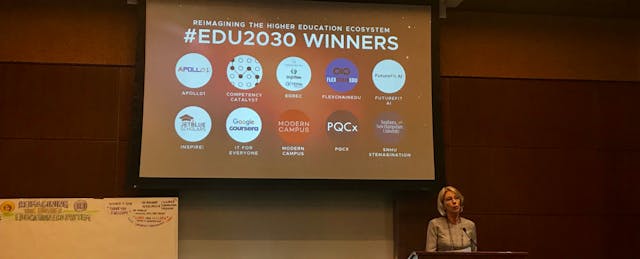The U.S. Department of Education’s Office of Educational Technology held its first major event in nearly two years on Thursday, and the main takeaway is that the office is busy planning for the future—2030, to be exact.
Education secretary Betsy DeVos, along with a handful of officials from the Office of EdTech, convened education leaders and entrepreneurs in Washington, D.C., to announce the winners of the “Reimagining the Higher Education Ecosystem,” or EDU2030, challenge.
The project called on higher education stakeholders—including students, faculty, investors, inventors and policymakers—to think outside the box and propose concrete solutions to the problems postsecondary education is expected to face at the end of the next decade: new industries emerging as technology advances, other industries disappearing as automation spreads and the stresses on the workforce that will result from both.
Over the summer, 164 teams from colleges, businesses and nonprofits submitted proposals. Their ideas had to touch on three areas of particular interest to the education department: new credentialing pathways, marketplaces for learning that allow students to record their acquired skills, and emerging technology such as blockchain, artificial intelligence and virtual reality.
The proposals also needed to promote equity, diversity and inclusion.
A panel of 18 judges selected 25 finalists, and then an online public vote determined the 10 winners. (Each of the 10 teams met the department’s criteria, though none included a VR component).
The winners will receive mentoring and unspecified “support” from the Department of Education, but no monetary prize.
Representatives of each winning proposal presented their ideas at the event Thursday, held at the National Academy of Sciences, to an audience of about 70 people.
One of the two top winners of the public voting was FutureFit AI, an AI-powered system that would act as “the Google Maps for the future of work and learning,” according to Hamoon Ekhtiari, the entrepreneur who presented his plan at Thursday’s event.
The pilot would first show students what career options are available to them (“explore the world”), then it would help them establish some goals (“set a destination”), understand where they are in that process and whether they have any college credit or skills to apply toward it (“locate yourself”), offer ways to get to their end goal (“suggest routes”) and then guide them as they go along.
Though fueled by artificial intelligence, the system would incorporate human support through advisers, Ekhtiari said.
The second people’s choice winner, Inspire, comes from the commercial airline JetBlue. With 22,000 crewmembers—the majority of whom are paid hourly and 40 percent of whom lack a college degree—JetBlue wanted to help its employees find a focused career path, according to Bonny Simi, president of JetBlue Technology Ventures.
The proposal identified two options that would meet a need of the airliner and help close the skills gap among crewmembers: IT support certification programs and flight school.
Once employees determine their degree path, they can begin taking online courses paid for by JetBlue. The company expects 180 crewmembers to graduate by the end of the year, Simi said.
“These examples are promising, and we need many, many more of them,” Education Secretary Betsy DeVos said during a brief speech at the event. “That’s why everyone in every community needs to rethink education.”
“New approaches to education,” she added, “will come from entrepreneurs, philanthropists, teachers and parents—those closest to students. And solutions may well come from students themselves.”
Indeed, some of the EDU2030 finalists were students from the University of Pennsylvania, Stanford University and Columbia University. But they were not able to make it to Washington for the event—they had class to attend.


